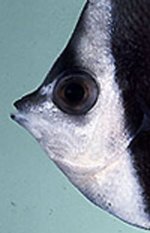A
Anonymous
Guest
I am often asked how to tell the difference between these two species of very closely related fish. The difference is an important one, because the two species reportedly have different tendencies to snack on corals.

There are several ways to distinguish the two species apart, including the position of the band at the tip of the anal fin and the shape of the breast, but I find these to be problematic (fin tips are often ripped) and/or difficult to readily distinguish. Variation occurs in individual fish making these traits hard to ascertain, and juveniles tend to change shape as they age. I find the easiest way to distinguish these fish is in the shape and size of the snout.
H. acuminatus has a longer mouth, with a greater distance between the tip of the mouth and the eyeball. Note the ridge or lip on the upper side of the mouth in H. acuminatus. (see below)
H. diphreutes, in contrast, has a much smaller and shorter mouth. The distance between the tip of the mouth and the eyeball is relatively shorter. (see second picture below)
The general consensus seems to be that H. acuminatus is NOT reef safe, and that H. diphreutes is reef safe. I am skeptical that IDing of these fish to the species level is done with any degree of certainty when hobbyists report their findings with these fish. I'd be curious to hear anybody's experiences with these fish while keeping them with coral, and ideally a photo of the fish.

There are several ways to distinguish the two species apart, including the position of the band at the tip of the anal fin and the shape of the breast, but I find these to be problematic (fin tips are often ripped) and/or difficult to readily distinguish. Variation occurs in individual fish making these traits hard to ascertain, and juveniles tend to change shape as they age. I find the easiest way to distinguish these fish is in the shape and size of the snout.
H. acuminatus has a longer mouth, with a greater distance between the tip of the mouth and the eyeball. Note the ridge or lip on the upper side of the mouth in H. acuminatus. (see below)
H. diphreutes, in contrast, has a much smaller and shorter mouth. The distance between the tip of the mouth and the eyeball is relatively shorter. (see second picture below)
The general consensus seems to be that H. acuminatus is NOT reef safe, and that H. diphreutes is reef safe. I am skeptical that IDing of these fish to the species level is done with any degree of certainty when hobbyists report their findings with these fish. I'd be curious to hear anybody's experiences with these fish while keeping them with coral, and ideally a photo of the fish.







